Mekiroki (Easy Removal Guide) - Free Instructions
Mekiroki Removal Guide
What is Mekiroki?
Mekiroki – a push notification portal that's alerts are deceptive ads
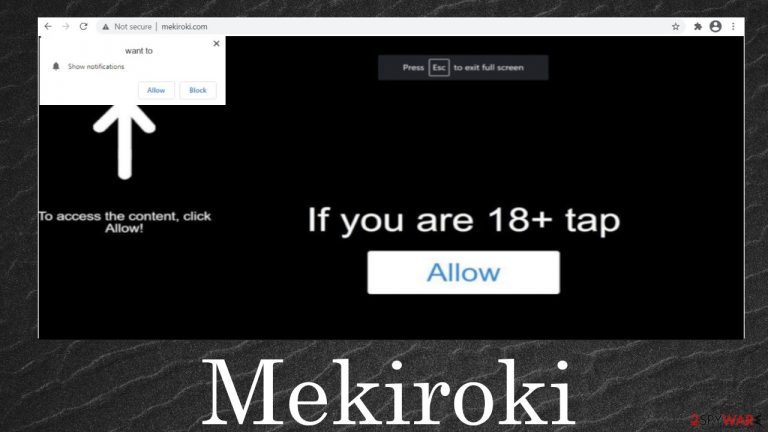
Mekiroki is a treacherous website developed to trick internet users into accepting its notifications. It does that by showing various misleading prompts. If you press the Allow button, you will start seeing ads in the form of notifications directly on your desktop or screen. Thus please refrain from doing that.
Otherwise, Mekiroki ads will start popping up. They are deceptive. The shown content doesn't match the affiliated sites, meaning an ad for an amazing deal on a new computer could redirect you to a sponsored site with potentially unwanted programs, other push notification viruses, etc.
The worse thing about these ads is that they can't be closed. Clicking the “X” button on their corners either does nothing or opens a tab with a sponsored page. You should only visit websites that you want, not the ones you are forced to. You'll find out how to remove cyber threats currently infecting your device, their risks, and spreading techniques by reading this article.
| name | Mekiroki |
|---|---|
| Type | PUP, adware, redirect virus |
| IP address | 54.197.148.150 |
| Purpose | Generate traffic for affiliated sites by showing deceptive ads and causing redirects |
| Symptoms | Ads in the top-right or bottom-right corner of the desktop or directly on your cell phone or tablet screen. Visibly slower device performance, sudden redirects to unknown portals |
| Risks | PUP and malware infections, financial losses, privacy issues, identity theft |
| Distribution | Fake Flash Player updates, deceptive ads, software bundles |
| Removal | Dependable anti-malware software should be on every device that's regularly used on the internet. It will block shady portals and prevent you from installing any PUPs or camouflaged malware |
| System health fix | Infections modify Registry keys and values, which may result in BSoDs,[1] severe lag, crashing, etc. Resolve all system-related issues by scanning your device with a time-proven FortectIntego system diagnostics tool |
In most cases, Mekiroki redirect is caused by an adware infestation. Although it is deemed a potentially unwanted program (PUP), it can cause a lot of trouble. In fact, it could even become a gateway to hazardous malware infections, such as ransomware, Trojans, etc.
The same can happen when Mekiroki virus is on your device. It can open new tabs of any of its affiliated sites with ill intentions by showing you deceptive ads and by causing sudden redirects. The ads might be customized specially for you to make them irresistible. But as soon as you push one, you might end up on portals with:
- malware,
- gambling,
- various scams,
- porn,
- PUPs, etc.
As mentioned before, you could be made into visiting these sites through sudden redirects when new browser windows are launched with any of the advertised content on-demand. Thus having Mekiroki or any other cyber infection on your device might pose real dangers to both of you.
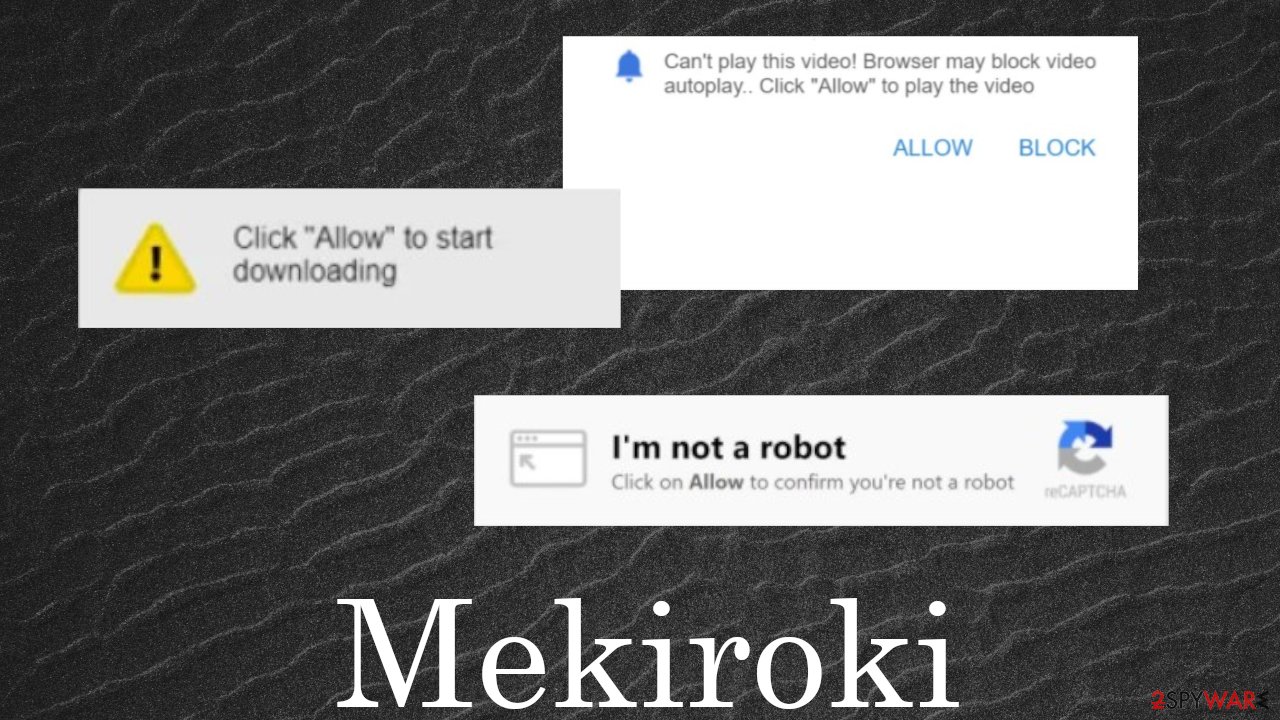
If you've clicked the Allow button when redirected to this shady portal, you need to remove Mekiroki notifications from your browser. You can do that with our free guides at the bottom of this article. Afterward, scan your device with trustworthy security tools like SpyHunter 5Combo Cleaner or Malwarebytes to make sure no PUPs or malware snook through.
And lastly, you have to take care of the overall health of your device after Mekiroki removal. According to cybersecurity experts,[2] the best tool to automatically get rid of tracking cookies and repair various system irregularities is the time-proven FortectIntego system diagnostics tool.
Please don't believe shady sites stating that you need to update your Flash Player
Lots of people don't know that Adobe has discontinued support for their Flash Player on December 31, 2020.[3] And cybercriminals are exploiting this unawareness by spreading their vile creations via the fake Flash Player installers or updates.
Deceptive ads or misleading prompts to download and install Flash Player could contain either a potentially unwanted program, such as adware, browser hijacker, etc., or severe malware, including keyloggers, ransomware, Trojans, and others.
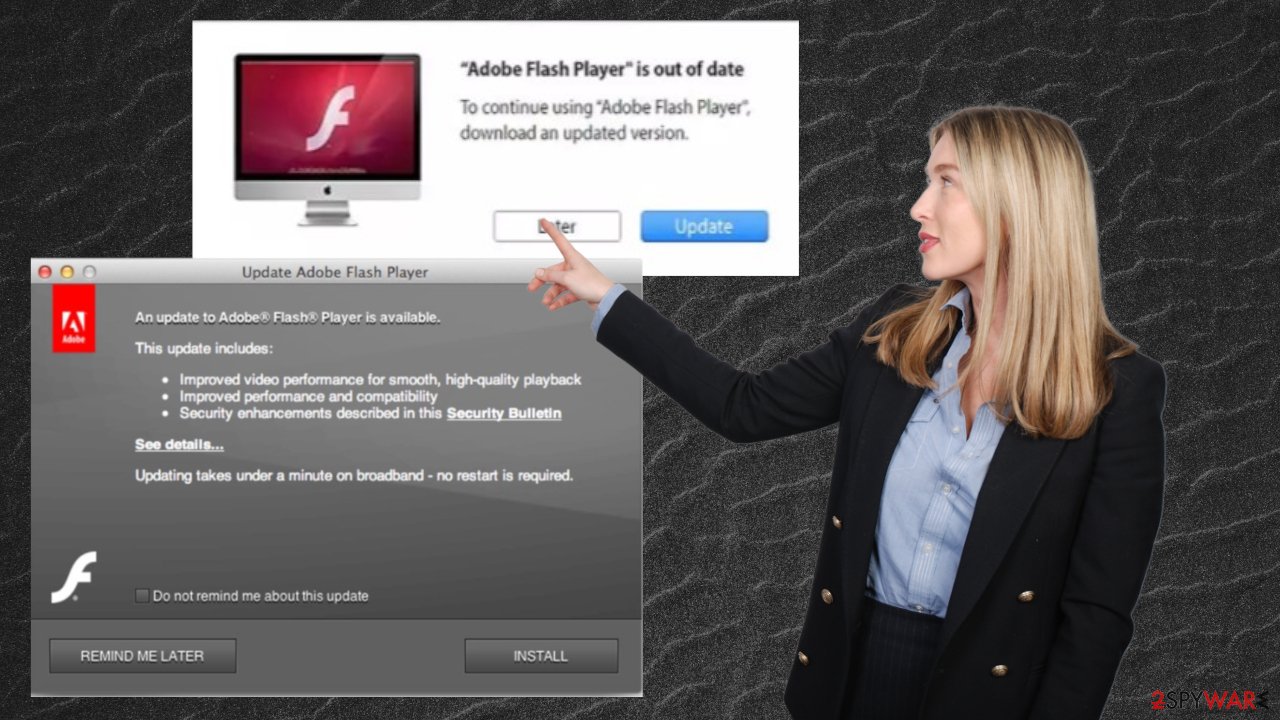
These prompts could be shown on legit sites that were hacked, so please remember that the Flash Player service is discontinued. If you see such an ad or a prompt, please close the tab immediately, clean your browsing history, and never visit that page again.
Remove Mekiroki ads within minutes with our free guidelines
Push notifications are great for receiving the latest sports updates, breaking news, awesome deals, and alike. But they have to be accepted only from legitimate sources. Mekiroki virus will not bring anything useful. It will diminish the performance of your device and may cause additional infections.
Therefore, you must remove Mekiroki as soon as possible. The easiest way to do that is by scanning your device in question with a robust anti-malware tool. Such software should always be up-to-date to prevent the latest infections from spreading to your device.
Once you've performed Mekiroki removal with AV tools, use our instructions below to eliminate it from your browser. That will stop the annoying ads. And lastly, use system repair software to ensure that the system files and folders are in order and won't cause any strange system behavior.
You may remove virus damage with a help of FortectIntego. SpyHunter 5Combo Cleaner and Malwarebytes are recommended to detect potentially unwanted programs and viruses with all their files and registry entries that are related to them.
Getting rid of Mekiroki. Follow these steps
Stop browser notifications
Remove unwanted notifications from Google Chrome (desktop):
- Open Google Chrome browser and go to Menu > Settings.
- Scroll down and click on Advanced.
- Locate Privacy and security section and pick Site Settings > Notifications.

- Look at the Allow section and look for a suspicious URL.
- Click the three vertical dots next to it and pick Block. This should remove unwanted notifications from Google Chrome.

Remove unwanted notifications from Google Chrome (Android):
- Open Google Chrome and tap on Settings (three vertical dots).
- Select Notifications.
- Scroll down to the Sites section.
- Locate the unwanted URL and toggle the button to the left (Off setting).

Remove unwanted notifications from Mozilla Firefox:
- Open Mozilla Firefox and go to Menu > Options.
- Click on Privacy & Security section.
- Under Permissions, you should be able to see Notifications. Click the Settings button next to it.

- In the Settings – Notification Permissions window, click on the drop-down menu by the URL in question.
- Select Block and then click on Save Changes. This should remove unwanted notifications from Mozilla Firefox.

Remove unwanted notifications from Safari:
- Click on Safari > Preferences…
- Go to the Websites tab and, under General, select Notifications.
- Select the web address in question, click the drop-down menu and select Deny.

Remove unwanted notifications from MS Edge:
- Open Microsoft Edge, and click the Settings and more button (three horizontal dots) at the top-right of the window.
- Select Settings and then go to Advanced.
- Under Website permissions, pick Manage permissions and select the URL in question.

- Toggle the switch to the left to turn notifications off on Microsoft Edge.

Remove unwanted notifications from MS Edge (Chromium):
- Open Microsoft Edge, and go to Settings.
- Select Site permissions.
- Go to Notifications on the right.
- Under Allow, you will find the unwanted entry.
- Click on More actions and select Block.

Remove unwanted notifications from Internet Explorer:
- Open Internet Explorer, and click on the Gear icon at the top-right of the window.
- Select Internet options and go to the Privacy tab.
- In the Pop-up Blocker section, click on Settings.
- Locate web address in question under Allowed sites and pick Remove.

Uninstall from Windows
Instructions for Windows 10/8 machines:
- Enter Control Panel into Windows search box and hit Enter or click on the search result.
- Under Programs, select Uninstall a program.

- From the list, find the entry of the suspicious program.
- Right-click on the application and select Uninstall.
- If User Account Control shows up, click Yes.
- Wait till uninstallation process is complete and click OK.

If you are Windows 7/XP user, proceed with the following instructions:
- Click on Windows Start > Control Panel located on the right pane (if you are Windows XP user, click on Add/Remove Programs).
- In Control Panel, select Programs > Uninstall a program.

- Pick the unwanted application by clicking on it once.
- At the top, click Uninstall/Change.
- In the confirmation prompt, pick Yes.
- Click OK once the removal process is finished.
Delete from macOS
Remove items from Applications folder:
- From the menu bar, select Go > Applications.
- In the Applications folder, look for all related entries.
- Click on the app and drag it to Trash (or right-click and pick Move to Trash)

To fully remove an unwanted app, you need to access Application Support, LaunchAgents, and LaunchDaemons folders and delete relevant files:
- Select Go > Go to Folder.
- Enter /Library/Application Support and click Go or press Enter.
- In the Application Support folder, look for any dubious entries and then delete them.
- Now enter /Library/LaunchAgents and /Library/LaunchDaemons folders the same way and terminate all the related .plist files.

Uninstall from Android
Uninstall unwanted programs from Android device:
- Go to Settings -> Apps/Applications.
- Expand the full list of the installed apps.
- Scroll through the list and tap on a suspicious application once.
- Tap on it and select Uninstall.
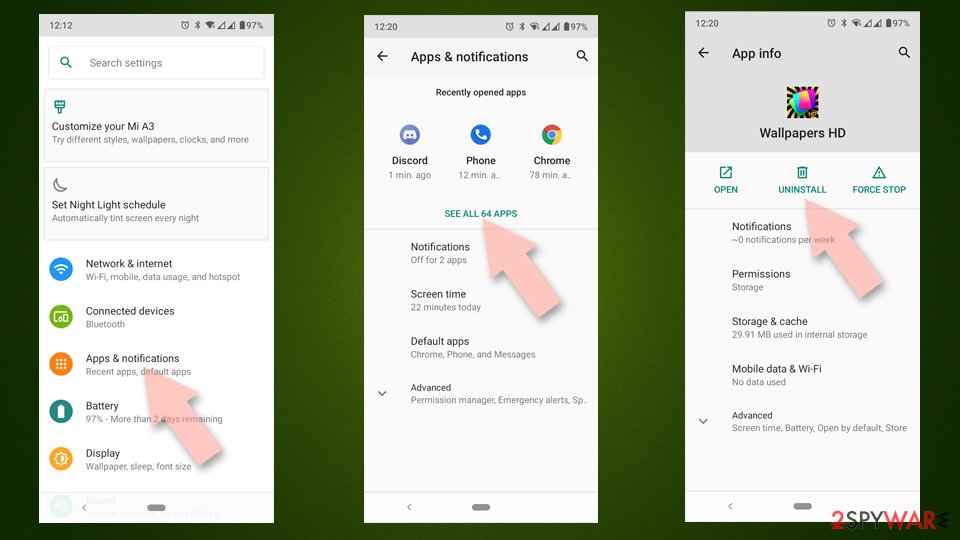
- Reboot the device.
Clear Storage and data files on Android from Google Chrome or other apps:
- Go to Settings > Apps/Applications.
- Expand the full list of the installed apps.
- Tap on Chrome and select Storage & cache.
- Clear storage and clear cache of the app.
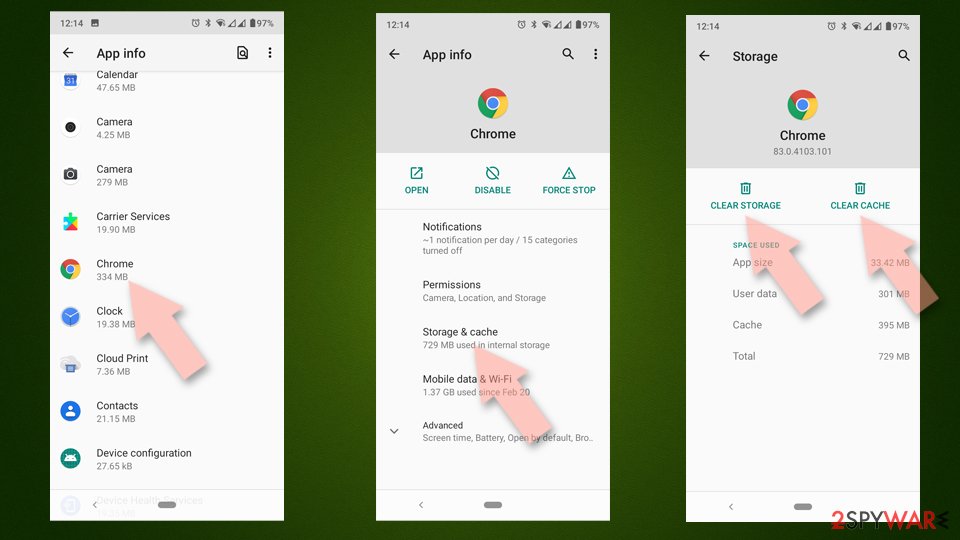
If you are seeing ads on top of other apps but are not sure what is causing it, perform the following steps:
- Go to Apps/Applications.
- Tap Advanced.
- Select Special App access.
- Tap on Display over other apps.
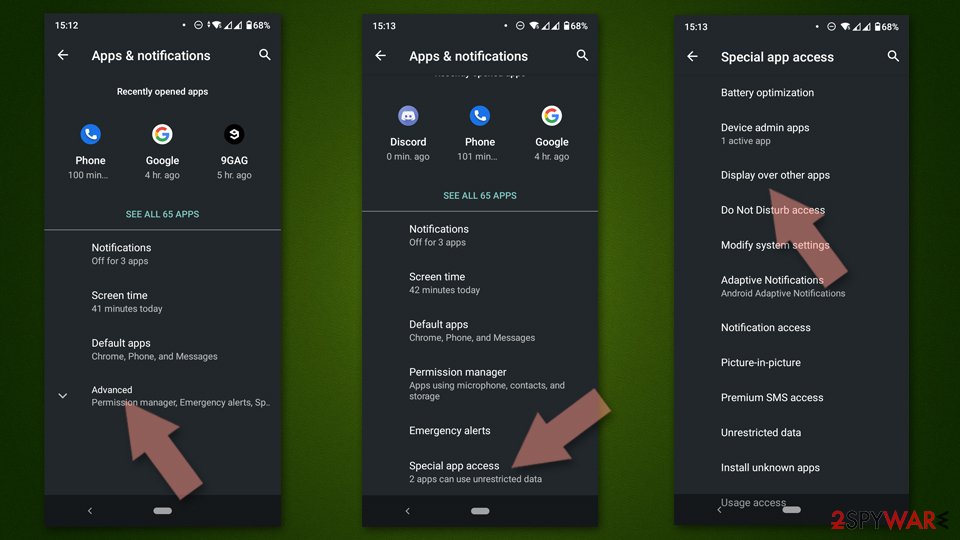
- Eliminate apps with these access rights enabled.
Remove from Microsoft Edge
Delete unwanted extensions from MS Edge:
- Select Menu (three horizontal dots at the top-right of the browser window) and pick Extensions.
- From the list, pick the extension and click on the Gear icon.
- Click on Uninstall at the bottom.

Clear cookies and other browser data:
- Click on the Menu (three horizontal dots at the top-right of the browser window) and select Privacy & security.
- Under Clear browsing data, pick Choose what to clear.
- Select everything (apart from passwords, although you might want to include Media licenses as well, if applicable) and click on Clear.

Restore new tab and homepage settings:
- Click the menu icon and choose Settings.
- Then find On startup section.
- Click Disable if you found any suspicious domain.
Reset MS Edge if the above steps did not work:
- Press on Ctrl + Shift + Esc to open Task Manager.
- Click on More details arrow at the bottom of the window.
- Select Details tab.
- Now scroll down and locate every entry with Microsoft Edge name in it. Right-click on each of them and select End Task to stop MS Edge from running.

If this solution failed to help you, you need to use an advanced Edge reset method. Note that you need to backup your data before proceeding.
- Find the following folder on your computer: C:\\Users\\%username%\\AppData\\Local\\Packages\\Microsoft.MicrosoftEdge_8wekyb3d8bbwe.
- Press Ctrl + A on your keyboard to select all folders.
- Right-click on them and pick Delete

- Now right-click on the Start button and pick Windows PowerShell (Admin).
- When the new window opens, copy and paste the following command, and then press Enter:
Get-AppXPackage -AllUsers -Name Microsoft.MicrosoftEdge | Foreach {Add-AppxPackage -DisableDevelopmentMode -Register “$($_.InstallLocation)\\AppXManifest.xml” -Verbose

Instructions for Chromium-based Edge
Delete extensions from MS Edge (Chromium):
- Open Edge and click select Settings > Extensions.
- Delete unwanted extensions by clicking Remove.

Clear cache and site data:
- Click on Menu and go to Settings.
- Select Privacy, search and services.
- Under Clear browsing data, pick Choose what to clear.
- Under Time range, pick All time.
- Select Clear now.

Reset Chromium-based MS Edge:
- Click on Menu and select Settings.
- On the left side, pick Reset settings.
- Select Restore settings to their default values.
- Confirm with Reset.

Remove from Mozilla Firefox (FF)
Remove dangerous extensions:
- Open Mozilla Firefox browser and click on the Menu (three horizontal lines at the top-right of the window).
- Select Add-ons.
- In here, select unwanted plugin and click Remove.

Reset the homepage:
- Click three horizontal lines at the top right corner to open the menu.
- Choose Options.
- Under Home options, enter your preferred site that will open every time you newly open the Mozilla Firefox.
Clear cookies and site data:
- Click Menu and pick Settings.
- Go to Privacy & Security section.
- Scroll down to locate Cookies and Site Data.
- Click on Clear Data…
- Select Cookies and Site Data, as well as Cached Web Content and press Clear.

Reset Mozilla Firefox
If clearing the browser as explained above did not help, reset Mozilla Firefox:
- Open Mozilla Firefox browser and click the Menu.
- Go to Help and then choose Troubleshooting Information.

- Under Give Firefox a tune up section, click on Refresh Firefox…
- Once the pop-up shows up, confirm the action by pressing on Refresh Firefox.

Remove from Google Chrome
Delete malicious extensions from Google Chrome:
- Open Google Chrome, click on the Menu (three vertical dots at the top-right corner) and select More tools > Extensions.
- In the newly opened window, you will see all the installed extensions. Uninstall all the suspicious plugins that might be related to the unwanted program by clicking Remove.

Clear cache and web data from Chrome:
- Click on Menu and pick Settings.
- Under Privacy and security, select Clear browsing data.
- Select Browsing history, Cookies and other site data, as well as Cached images and files.
- Click Clear data.

Change your homepage:
- Click menu and choose Settings.
- Look for a suspicious site in the On startup section.
- Click on Open a specific or set of pages and click on three dots to find the Remove option.
Reset Google Chrome:
If the previous methods did not help you, reset Google Chrome to eliminate all the unwanted components:
- Click on Menu and select Settings.
- In the Settings, scroll down and click Advanced.
- Scroll down and locate Reset and clean up section.
- Now click Restore settings to their original defaults.
- Confirm with Reset settings.

Delete from Safari
Remove unwanted extensions from Safari:
- Click Safari > Preferences…
- In the new window, pick Extensions.
- Select the unwanted extension and select Uninstall.

Clear cookies and other website data from Safari:
- Click Safari > Clear History…
- From the drop-down menu under Clear, pick all history.
- Confirm with Clear History.

Reset Safari if the above-mentioned steps did not help you:
- Click Safari > Preferences…
- Go to Advanced tab.
- Tick the Show Develop menu in menu bar.
- From the menu bar, click Develop, and then select Empty Caches.

After uninstalling this potentially unwanted program (PUP) and fixing each of your web browsers, we recommend you to scan your PC system with a reputable anti-spyware. This will help you to get rid of Mekiroki registry traces and will also identify related parasites or possible malware infections on your computer. For that you can use our top-rated malware remover: FortectIntego, SpyHunter 5Combo Cleaner or Malwarebytes.
How to prevent from getting adware
Access your website securely from any location
When you work on the domain, site, blog, or different project that requires constant management, content creation, or coding, you may need to connect to the server and content management service more often. The best solution for creating a tighter network could be a dedicated/fixed IP address.
If you make your IP address static and set to your device, you can connect to the CMS from any location and do not create any additional issues for the server or network manager that needs to monitor connections and activities. VPN software providers like Private Internet Access can help you with such settings and offer the option to control the online reputation and manage projects easily from any part of the world.
Recover files after data-affecting malware attacks
While much of the data can be accidentally deleted due to various reasons, malware is one of the main culprits that can cause loss of pictures, documents, videos, and other important files. More serious malware infections lead to significant data loss when your documents, system files, and images get encrypted. In particular, ransomware is is a type of malware that focuses on such functions, so your files become useless without an ability to access them.
Even though there is little to no possibility to recover after file-locking threats, some applications have features for data recovery in the system. In some cases, Data Recovery Pro can also help to recover at least some portion of your data after data-locking virus infection or general cyber infection.
- ^ Chris Hoffman. Everything You Need To Know About the Blue Screen of Death. Howtogeek. Online technology magazine.
- ^ Viruset. Viruset. Spyware news and security.
- ^ Adobe Flash Player EOL General Information Page. Adobe. An american multinational computer software company.
